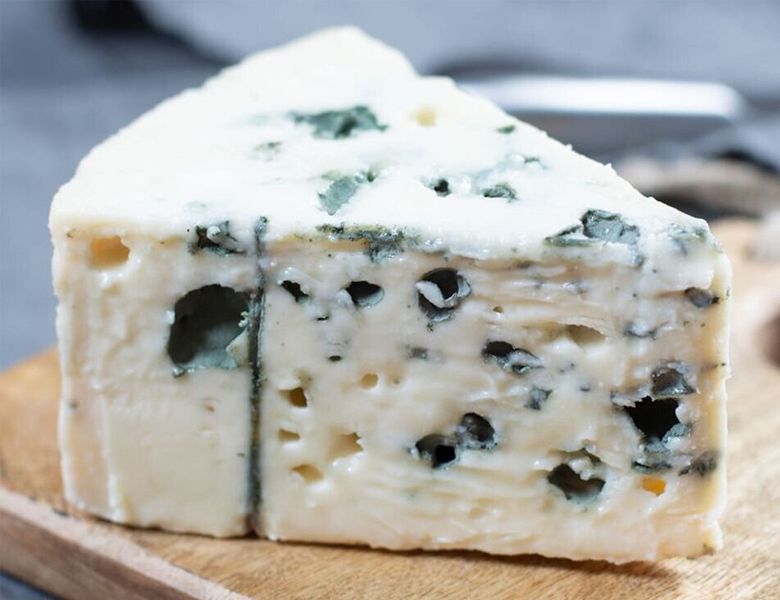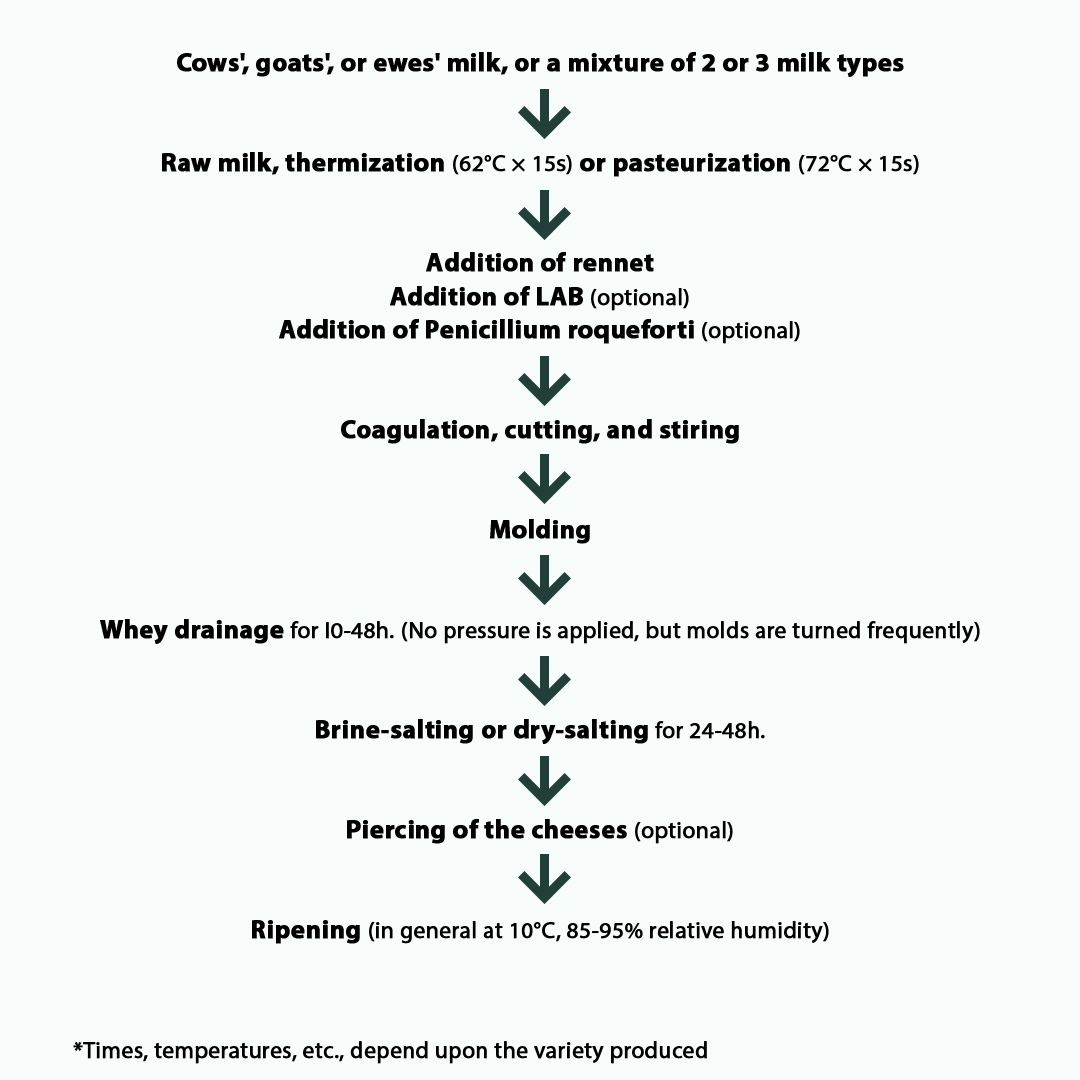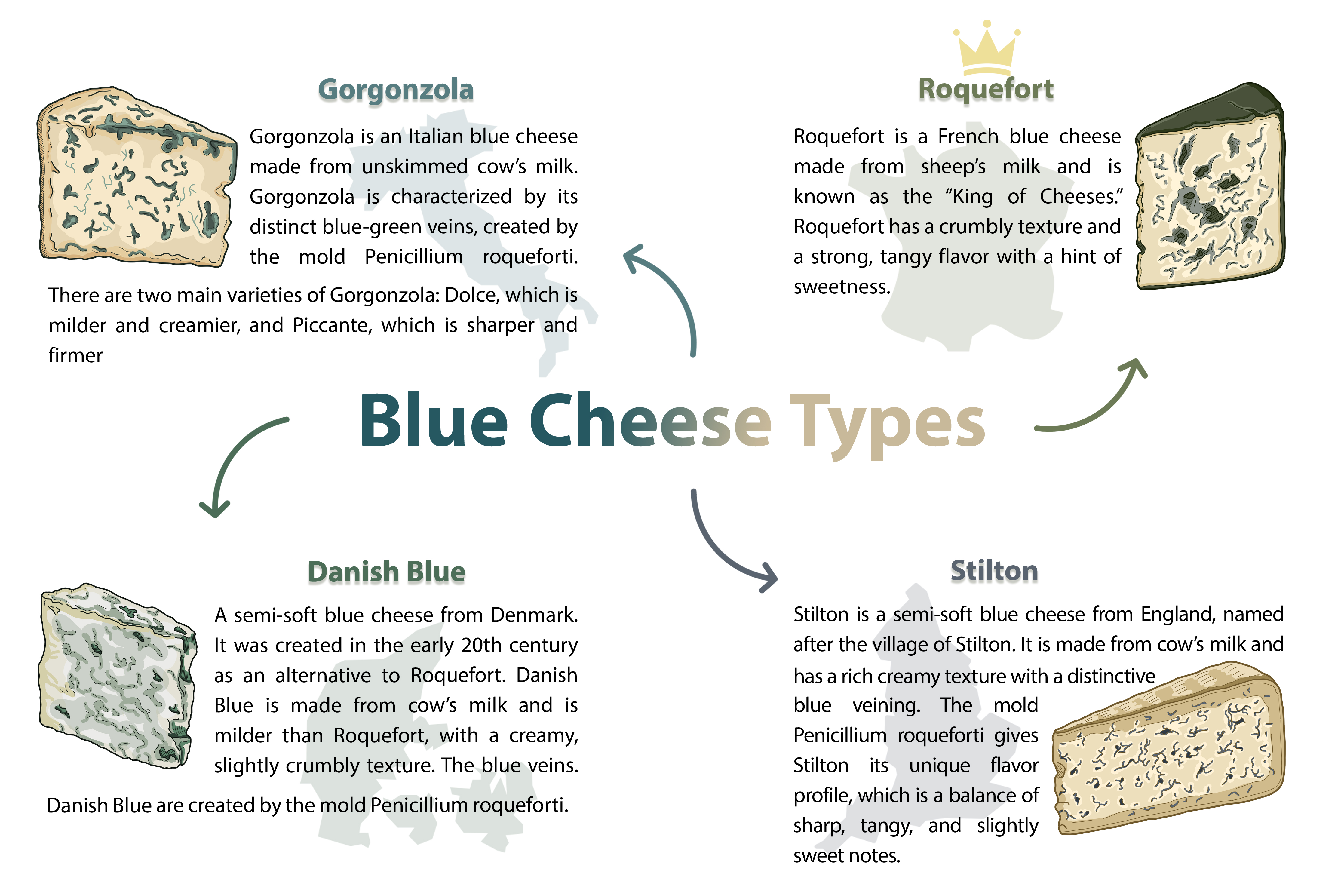Everything about Blue cheese

- | آتاماد |
- Viewer: 174
If you have ever seen blue cheese, you must have asked yourself where do these blue veins come from? These veins are caused by Penicillium roqueforti within the cheese matrix, which is itself a complex collection of individual components/nutrients. Biochemical activities, mainly of microbial origin, are responsible for the sensory characteristics of this cheese.
Blue cheeses are semi-hard cheeses, depending on their type, they have a fresh dry matter between 50-60%, a fat content of 30-40%, a protein content of 20-30%, and inconsistent salt content that depends on whether the curd is cut into small or dry pieces. More than 45 types of blue cheese are produced worldwide, each with its own unique characteristics, although the production process is similar in all of them.
Blue cheese production
Blue cheeses undergo complex fermentation and ripening processes mainly by lactic acid bacteria (LAB) and fungi. P. roqueforti is a common secondary starter culture for blue cheese production and contributes greatly to the flavor and color of the final product, although fungi other than P. roqueforti may be present in traditional blue cheese production.
P. roqueforti is particularly adapted to the conditions encountered during blue cheese production, including low oxygen levels and low temperatures. This species also actively participates in lipolysis and proteolysis and produces many aroma compounds, among which methyl ketones are the most abundant.

Figure 1. Blue cheese production flow chart
In addition to P. roqueforti, complex microbial populations interact and succeed throughout the manufacturing and ripening at the cheese’s surface (the rind) and interior (matrix). The microbiota or microbial population of blue cheeses consists of a wide range of prokaryotic and eukaryotic microorganisms. Curd acidification depends on the activity of lactococci and other species of LAB. The final quality and shelf life of ripened cheeses largely depend on the enzyme systems of the microbiota components, especially on LAB, Roqueforti, and yeast species systems.
The production method:
The method of producing blue cheese is as follows: addition of P. roqueforti spores, addition of heterofermentative lactic cultures (such as Leuconostoc), cutting the curd into small pieces, dry or less frequently brine-salting, needling or piercing of cheese (facilitating the entry of air and the possibility of uniform growth of P. roqueforti in the cheese matrix), and ripening at about 10 °C and relatively high humidity (85-95%), is done in at least 1-2 months.
Traditionally, cheeses became naturally contaminated with P. roqueforti from manufacturing and ripening environments. However, it is common to add commercial spores to cheese on an industrial production scale.
Types of blue cheese
More than 45 types of blue cheese are produced worldwide. Among them, the best-known species come from Europe, all of which have been granted Protected Designations of Origin (PDO) or Protected Geographical Indications. Gorgonzola and then Roquefort are among the first known blue cheeses.

Figure 2. The most famous blue cheeses and their characteristics.
Blue cheeses are usually made from cow's milk, although they may be made with raw or pasteurized milk from ewe, or sometimes goat or a mixture of them. For example, in France, most blue cheeses except Roquefort are made with cow's milk, while in Spain and Greece, sheep's milk is usually added to cow's milk. For example, Cabrales is a Spanish blue cheese made from a mixture of cow's, sheep's, and goat's milk.
Blue cheese microbiota
The microbiota of blue cheese is complex, especially when raw milk is used in its production. Lactic acid bacteria (LAB) and fungi are dominant species in this microbial population. Among the lactic acid bacteria, apart from Lactococcus spp., Leuconostoc is also commonly present, which work in favor of open texture in cheese. Among the fungi, apart from P. roqueforti, there are usually a variety of yeasts, all of which play a role in creating the characteristics of the final product.
Ecological factors affecting microbiota
Ecological factors that affect cheese microbiota are somewhat variable depending on the type of blue cheese. The pH of cheese reaches 5 in the first days of production and 6-7 at the end of ripening (the pH increases faster inside the cheese than on its surface). This increase is due to lactic acid degradation by non-LAB molds (P. roqueforti), and yeasts, and proteolysis. In the final stages of cheese production, sodium chloride content is between 3-4%. pH and salt in the gradient of humidity and low temperature are the physicochemical factors that cause the creation of secondary microbiota and contribute to the enzymatic activities required for cheese ripening.
Lactic acid bacteria
The milk type and technological processing affect the microbiota of cheese during the production and ripening stages and as a result its final sensory characteristics. Most traditional blue cheeses (for example, Roquefort, Gorgonzola, Cabrales, Gamonéu, etc.) are still produced with raw milk and based on traditional technologies. Therefore, it is not unexpected to have high diversity in microbial populations with different flavor profiles. To produce blue cheese in an industrial way, mesophilic LAB strains (such as Lactococcus lactis, Lactococcus cremoris, and Leuconostoc) are used as starter cultures. But in the production of Gorgonzola cheese, as an exception, a mixture of mesophilic and thermophilic LAB species (Streptococcus thermophilus and Lactobacillus delbrueckii) is used.
LAB species responsible for taste
Lactic acid strains of Lactis biovar diacetylactis (Lc. Lactis, subsp. Lactis biovar diacetylactis), are often included in mesophilic cultures because this microorganism is able to catabolize citrate to CO2 and the flavor compound diacetyl, which gives the cheese its distinctive buttery flavor. In addition, Leuc. Mesenteroides subsp. cremoris strains are also added due to their ability to produce flavor (diacetyl), but mostly due to their CO2 production and subsequently the formation of eyes, helping the growth of Penicillium inside the cheese.
Yeast and molds
P. roqueforti is the main ripening reason for blue cheeses and is responsible for the visual aspect as well as the texture, flavor, and aroma. However, especially in cheeses made from raw milk, a large number of yeast species can grow together with P. roqueforti and other molds, which together constitute the blue cheese microbiota. During ripening, yeasts reach the majority of its population. Both P. roqueforti and yeasts have strong proteolytic and lipolytic systems that help convert milk components into flavor compounds.
The importance of selecting the right species
For years, blue cheeses have been produced in a completely natural way. But today, the production of blue cheese under controlled conditions and the use of selected strains of P. roqueforti are common methods in the cheese industry and are considered necessary to obtain a product with desirable characteristics. To select strains, several characteristics are evaluated: proteolytic and lipolytic activities, color, germination, growth rate at ripening temperatures, salt tolerance, and mycotoxigenicity.
The microbiota of blue cheeses deserves further description, as it may be a source of new species. The overall quality of blue cheese is thought to result from the coordinated action of all members of the microbiota, which is shaped by a remarkable diversity of bacterial and fungal species.
Pathogens and Spoilage in Blue Cheese
P. roqueforti produces about a dozen secondary metabolites, some of which are toxic, such as PR-toxin, and may cause health problems. In addition, it may produce a wide range of mycotoxins, some of which have been found in very low concentrations in commercial blue cheeses. Considering this fact, the relatively low toxicity of mycotoxins, and the instability of some of them, the high consumption of blue cheese does not pose a risk to the consumers’ health. Therefore, the strains that have the least toxicity should be used in cheese production.
Mycotoxin production
Other microbiological hazards associated with ripened cheeses are the presence of toxic substances produced by microorganisms such as biogenic amines and mycotoxins. Biogenic amines are found in blue cheeses following proteolysis due to microbial activity and ultimately affect the quality of the final product. Consuming foods containing high amounts of toxic biogenic amines may cause food poisoning. In terms of food safety, the most important of them are histamine and tyramine. The Panel on Biological Hazards (BIOHAZ) of the European Food Safety Authority (EFSA) reported a qualitative risk assessment of biogenic amines (histamine, tyramine, cadaverine, and putrescine) in fermented foods, which included ripened cheeses in the main category containing biogenic amines. The possibility of using high-quality P. roqueforti strains that are not able to produce secondary metabolite toxins in cheese is of great interest.
Blue cheese defects
By growing on the surface of blue cheeses, the spoilage agent counteracts the activity of the microbial starters (P. roqueforti and LAB), and thus can cause undesirable changes (discoloration, bad taste) in the cheese.
Meanwhile, P. caseifulvum has been frequently detected on blue cheeses and facilities and is associated with cheese discoloration. In addition, G. candidum has also been reported to both aid cheese ripening and sometimes inhibit P. roqueforti. Another biological cause of spoilage of blue cheese is the presence of mites. Mites grow on the surface and possibly feed on the fungi, causing economic losses as well as health problems (allergy, transmission of microorganisms, and even prion reservoir).

Table 1. Common spoilage agents of blue cheese
Proteolysis and lipolysis
Proteolysis or removal of peptide bonds is the most complex and important primary biochemical process that occurs in blue cheeses during ripening. Hydrolysis helps soften the texture of the cheese, and proteolysis, or the production of small peptides and amino acids has a direct effect on flavor. In blue cheeses, several agents are responsible for proteolysis: proteinases released by starter culture lactic acid bacteria (SLAB) and non-starter lactic acid bacteria (NSLAB), rennet, native milk proteinases, and especially proteinases and exo- and endopeptidases produced by P. roqueforti.
The importance of proteolysis and lipolysis
Despite being weakly proteolytic, LABs have a very extensive proteinase/peptidase system. Although the proteolytic activity of P. roqueforti varies greatly among strains, it is considered the main proteolytic agent in all blue cheeses. The proteolytic activity of the fungal strain is very important for texture development, while the lipolytic ability is essential for aroma development. If there is not enough proteolysis, the cheese will be dry and hard, while if there is too much, it may be too soft. In addition, high lipolysis is associated with a more intense taste.
Sensory characteristics
The unique characteristics of blue cheese are largely due to the growth of P. roqueforti. The flavor of the final product is mainly due to the lipolytic and proteolytic activity of this mold. Penicillium is the main fungus responsible for the degradation of lipids in this type of cheese, which produces a wide range of aroma compounds.
Color:
Depending on the type of milk used, the color of the inner part of the cheese is white light yellow, which is covered with mold veins. The color of mold veins can be blue, blue-gray, or blue-green depending on the strain used. As for the growth of P. roqueforti, the presence of an open texture and a minimum amount of oxygen is necessary. Other sensory characteristics are the result of intense proteolysis and lipolysis that take place inside the cheese.
Texture:
The texture of blue cheeses is usually soft, smooth, and creamy, although some may be sliceable and spreadable, or may crumble when cut. The rind is natural, soft, and thin, with different colors (orange-brown, grayish, reddish, or yellow) due to microbial growth on the surface. Some types of blue cheese, such as Cabrales and Roquefort, are wrapped in aluminum foil after they are ready to be consumed.
Aroma:
The aroma of these cheeses is usually intense, pleasant, and penetrating with fruity, floral, and spicy notes that originate from methyl ketones. Blue cheeses usually have a rather spicy, salty, and acidic taste.
Bottom line
The sensory characteristics of blue cheeses are based on complex biochemical reactions, which are largely due to the diverse microbiota in which fungi and bacteria actively participate. Although studies have been conducted on the microbiology and biochemistry of blue cheeses in recent years, more research is needed, especially on the characterization of industrial cheeses. This allows us to maintain the global diversity of available blue cheeses, making a wide variety of cheeses available to the consumer. In addition, more research is needed to clarify the role of bioactive compounds produced during the ripening period, such as GABA or bioactive peptides, on the performance of these species.
Reference:
GET IN TOUCH
Copyright © 2023 Atamad.com All right reserved
Website design and SEO services by Seohama team – Web hosting by Sarverhama
Copyright © 2023 Atamad.com All right reserved
Website design and SEO services by Seohama team – Web hosting by Sarverhama









